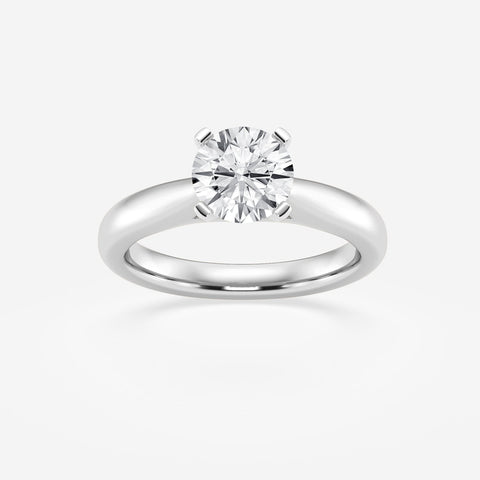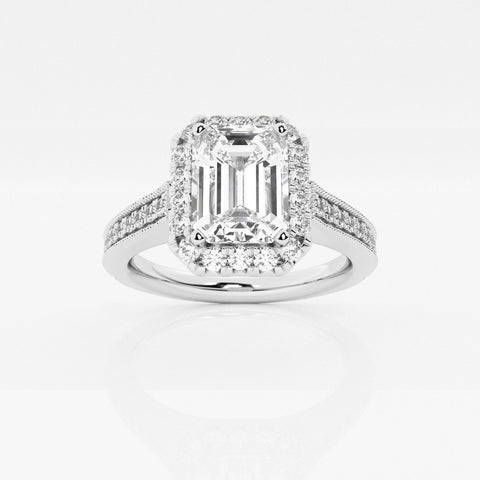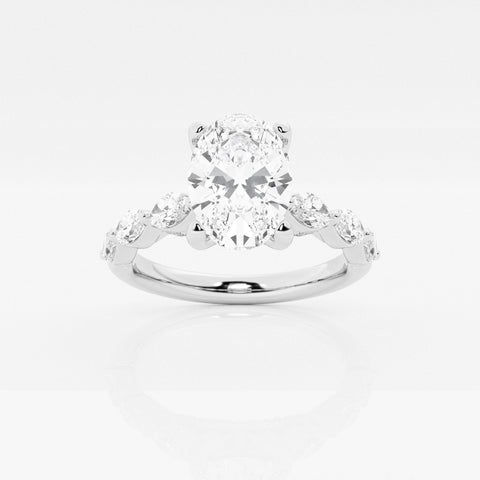Get ready to embark on a thrilling adventure in the quest for the perfect engagement ring! Just like in any great journey, you'll have choices to make, and your decisions will pave the way to a sparkling destination that's uniquely yours.
"Claws" or "prongs" are metal projections or settings that grip the diamond securely in place. The number and design of these claws can vary depending on the ring's design and the type of diamond being used. The purpose of these claws is to hold the diamond firmly while allowing light to enter and enhance its spark and elegance.
Lab-grown diamond engagement rings are not only more sustainable, and affordable than mined diamonds but also can be customized to your liking. Designing your diamond ring with every aspect, and setting, is made possible by Dream diamonds.
So, fasten your seatbelts, and let's explore the realm of engagement rings, one claw at a time, as we uncover the perfect setting for your radiant diamond!
Types of Ring Settings & Number of Claws
Traditionally, engagement diamond ring settings have either four or six claws, although other newer configurations are made possible. The number and style of claws affect the appearance and security of the diamond on the ring. More claws can provide added security, while fewer claws can showcase more of the diamond’s surface.
Here are some common types of prong settings that would work perfectly with our lab-grown diamond engagement rings:

Four-Prong (or Four-Claw) Setting:
This setting uses four metal prongs to secure the diamond at equal intervals around its circumference. It offers a balance of security and visibility for the diamond.
The round-cut engagement rings are a classic choice for a four-prong setting. The circular shape of the Round Brilliant Cut diamond complements the symmetry of the setting and maximizes shine.
Pros:
- Allows significant light to enter the diamond, enhancing its brilliance and sparkle.
- Holds the diamond securely in place with four prongs.
- Offers a classic and timeless look.
Cons:
- Can cover more of the diamond's surface compared to other settings.
- Prongs may catch on clothing or objects due to their position and shape.

Six-Prong (or Six-Claw) Setting:
The six-prong setting, as the name suggests, uses six metal prongs to secure the diamond. This setting provides extra security and may also enhance the roundness of a diamond’s appearance.
Round Brilliant Cut: Similar to the four-prong setting, the round-cut engagement rings work exceptionally well in a six-prong setting, showcasing the diamond's brilliance and providing added security.
Pros:
- Provides additional security and stability with six prongs.
- Enhances the roundness and brilliance of a diamond.
- Offers a classic and elegant appearance.
Cons:
- More prongs can potentially obscure a larger portion of the diamond compared to fewer prong settings.
V-Prong Setting:
In this setting, the prongs are shaped like a "V," providing additional protection to the diamond and maintaining a sleek and elegant appearance.
Pear Cut: The V-shaped prongs in a V-prong setting harmonize well with pear-shaped lab-grown diamond engagement rings. The prongs follow the contour of the diamond, creating a cohesive and visually pleasing look.
Pros:
- Offers a modern and stylish appearance.
- Provides excellent security for the diamond with the V-shaped prongs.
- Can emphasize the diamond's shape and size.
Cons:
- Prongs may require regular maintenance to ensure they remain secure and maintain their shape.

Channel Setting:
In a channel setting, diamonds are set within a channel of metal without individual prongs. The metal secures the stones and creates continuous, streamlined-looking lab-created diamonds for the rings.
Baguette-Cut: Baguette-cut diamonds, with their elongated rectangular shape, align well within a channel setting. They create a continuous and streamlined look along the band.
Pros:
- Creates a smooth, continuous appearance along the band.
- Offers secure placement and protection for the diamonds.
- Ideal for showcasing a series of smaller diamonds.
Cons:
- Limited light exposure to the diamonds reduces overall brilliance.

Tiffany Setting:
The Tiffany setting is a specific type of prong setting with six slender prongs designed to lift the lab-created diamonds, allowing maximum exposure to light and enhancing their brilliance.
Round Brilliant Cut: The classic Tiffany setting is often paired with a round brilliant-cut diamond, as the prongs are specifically designed to enhance the brilliance and radiance of a round diamond.
Pros:
- Maximizes light exposure and enhances diamond brilliance.
- Offers a classic and elegant appearance.
- Provides a secure and balanced hold for the diamond.
Cons:
- May require more frequent cleaning to maintain the diamond's shine and luster.

Cluster Setting:
In a cluster setting, multiple smaller diamonds are set closely together to create the appearance of a larger, unified diamond. Prongs secure each stone.
The choice of prong setting depends on the type of diamond, the design of the ring, the desired level of security, and the aesthetic preferences of the wearer. Different settings can highlight the diamond’s beauty and overall appearance in unique ways.
Various Shapes (Round, Princess, Marquise, etc.): A cluster setting can incorporate various diamond shapes, including rounds, princess cuts, marquise cuts, and others, to create a visually dynamic and unique design.
Pros:
- Creates the illusion of a larger diamond through the arrangement of smaller diamonds.
- Allows for creative and versatile design options.
- It can be cost-effective compared to using a single large diamond.
Cons:
- Prongs for multiple stones may require more maintenance and care to remain secure.
In the grand conclusion of our journey, we've unveiled the secret to enduring brilliance: durability. Just like a cherished love story, the strength of ring settings depends on craftsmanship, choice of metal, and regular care. So, as you make your final choice, consider your lifestyle and daily activities to ensure your diamond's everlasting shine. With the perfect setting, your love story will continue to sparkle for a lifetime.
At Dream Diamonds, your dreams take center stage. Handpick your perfect setting, infuse it with your desired inspiration, and watch as we turn your vision into reality. Whether you Design your own ring or explore our extensive collection, we're confident you'll discover something you'll absolutely adore. Your love story deserves nothing less!



